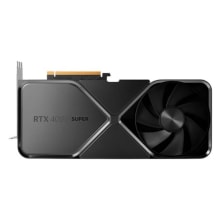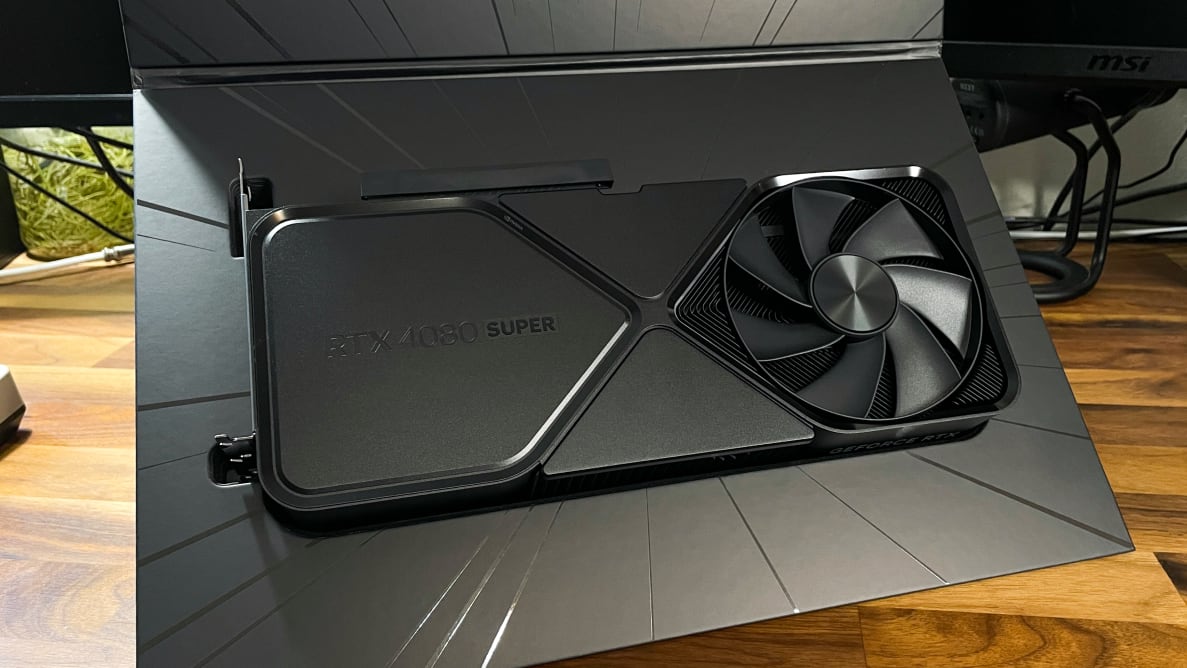Pros
-
Price cut compared to original 4080
-
Excellent performance
-
Good thermal and noise levels
Cons
-
Still enormous
-
Negligible performance improvement over non-Super version
-
Requires a tangle of adapter cables
About the Nvidia RTX 4080 Super

The Nvidia RTX 4080 Super delivers a modest performance boost over the discontinued 4080, but it's also less expensive than the original.
The RTX 4080 Super, on paper, looks like a marginal bump in specs over the now-discontinued RTX 4080. The number of CUDA cores has been bumped up from 9,728 to 10,240, the base clock is slightly faster at 2.29 GHz versus 2.21 Ghz, and the boost clock has seen a similar increase, now hitting 2.55 GHz up from 2.51 GHz. Those hoping for a major performance bump will be disappointed.
The biggest change is price; rather than charge more for the Super version of the RTX 4080, Nvidia has slashed the price from $1,200 to $1,000. Of course, this is only for the Founders Edition version that Nvidia manufactures and sells through Best Buy. Being the most affordable and oftentimes smallest versions, these cards are likely to sell out fast. Third-party alternatives will cost a smidge more; the MSI RTX 4080 Super Expert, which uses a stylish die-cast aluminum cooler, sells for $1,150, while more basic models like the Gigabyte RTX 4080 SUPER Windforce V2 and PNY RTX 4080 SUPER VERTO can be found for $1,000.
The color has also changed. Whereas Nvidia’s RTX 30- and 40-series GPUs used a silver and black industrial design palette, the Founders Edition 4070 Super and 4080 Super refreshes opt for a sleek all-black look.
We tested the RTX 4080 Super Founders Edition, which lacks the slight overclock that third-party cards may provide. Our test system consisted of an AMD Ryzen 9 7950X3D processor, an MSI MPG B650I Edge motherboard with 32GB of Corsair Dominator Titanium RAM running at 6000MHz, and an EVGA SuperNOVA 750 GM 750-watt, 80 Plus Gold power supply.
Nvidia RTX 4080 Super specs
- Price: $1,000
- CUDA Cores: 10,240
- Tensor Cores: 836
- Base clock: 2.29 GHz
- Boost clock: 2.55 GHz
- Memory: 16 GB GDDR6X
- Memory interface width: 256-bit
- Display support: 7680 x 4320, up to four monitors
- Ports: 1x HDMI 2.1a, 3x DisplayPort 1.4a
- Maximum power draw: 320 Watts
What we like
It’s a less expensive RTX 4080

The MSRP cut over the original 4080 is a welcome change.
The first thing I noticed after installing the 4080 Super (apart from the prodigious size) is that its performance blows the pants off of the Asus ProArt 4070 Ti I use for everyday gaming.
That’s to be expected. The original Nvidia RTX 4080 (now discontinued) is about 20% to 30% faster than the original 4070 Ti—also discontinued—depending on the resolution and game but retailed for $400 more at $1,200. That’s not exactly an exciting value proposition, but neither was the original 4070 Ti.
The 4080 Super’s $1,000 price tag is much more palatable, especially when it’s hard to find an RTX 4090 for anywhere close to its $1,600 MSRP.
After running the 4080 Super through our standard suite of GPU benchmarks, including both synthetic and real-world game testing, it’s clear that this GPU has the juice. It’s only a few percentage points faster than the original RTX 4080, but that means you get the top-tier 1440p performance and good 4K performance for $200 less.
It’s plenty powerful
The RTX 4080 Super is currently the second-most powerful Nvidia GPU you can buy, but what does that mean for games? Expect fantastic performance at every resolution, especially when Nvidia DLSS and frame generation are enabled—but you might not even need it.
Even newer games that my 4070 Ti requires DLSS to run with ray tracing turned on had no such issues here. Returnal at 1440p on the epic preset with ray tracing averaged 118 frames per second (fps) in the built-in benchmark and 65 fps at 4K, more than playable even before upscaling is enabled. I loaded up a late-game Baldur’s Gate 3 save in the Lower City at 4K with every setting maxed out and achieved a very respectable 90 to 110 fps, something my 4070 Ti can’t manage even in the much easier to run first act without DLSS. Swinging around Manhattan in Spider-Man: Miles Morales in 4K with every setting at its maximum, including ray tracing, runs at a comfortable 60 fps and even higher indoors.
Of course, some games will still require upscaling to run smoothly. In Alan Wake 2 at 4K with the ultra-graphics preset and path tracing enabled, even with DLSS turned on and set to quality and frame generation, we only measured about 60 fps in open-world areas like Cauldron Lake, and an 80-fps average in more enclosed sections like Saga’s Mind Place. That’s certainly playable but enabling Nvidia’s frame generation feature when a game is rendering below 60 fps without it often feels sluggish. I would recommend turning the settings down instead. At 1440p it’s a totally different story, as I measured a 60-fps average in open areas without frame generation using the same settings as above, and about 100 fps when it’s turned on.
Cyberpunk 2077 was no different, measuring 118 fps at 1440p using the ultra-preset, and 67 fps at 4K (both with ray tracing disabled). That’s about the same at 1440p as the original RTX 4080, and a 4% increase at 4K over the original’s 64 fps. Enabling ray tracing with the same settings returned 60 fps at 1440p and 30 fps at 4K, the exact same as our initial RTX 4080 non-Super benchmarks. In fact, the only game where I found a significant uplift over the original RTX 4080 was in the slightly older Borderlands 3. At 1440p on the Badass graphical preset, I recorded a 170-fps average, about 5 frames more than the original RTX 4080 (or 3%); at 4K, I measured an average of 95 fps, a 7% improvement over the 4080’s 89 fps average.
These results shouldn’t be surprising for RTX 4080 owners: they’re nearly identical across the board. In synthetic benchmarks like 3DMark, the RTX 4080 Super barely edges out the original. For instance, in 3DMark’s Time Spy test, I measured an average score of 28,746 at 1440p versus 28,087 (a 2.3% increase) and 15,104 at 4K in the same test versus 14,026 (a 7.6% increase). The results are even closer in 3DMark’s Port Royal test, which measures ray tracing capabilities; the RTX 4080 Super achieved about the same score as the non-Super model at 1440p with a score of 17,870, and barely managed a 1.7% improvement at 4K (8,665 versus 8,512).
So, if you already own an RTX 4080, the Super model isn’t an upgrade. But for everyone else, the $200 price cut might make it a much more compelling buy.
It runs cool and quiet
The 4080 Super might be just as large as its predecessor, but with an overbuilt cooler comes excellent temperatures even when under heavy load.
My PC case might have a mesh panel right in front of the GPU’s intake fan, but even when fully stressed and pulling the maximum 320 watts it’s rated for, our test card topped out a very respectable 68.4 degrees Celsius, with a hot spot temperature of just 78.9 degrees Celsius. In fact, in all of my testing, temperatures never crossed 70 degrees Celsius. It’s quiet, too, even under full load, and never became audibly noticeable.
After 20 runs in 3DMark’s Time Spy stress test, the 4080 Super maintained a clock frequency of 2805 MHz for every single run. That’s impressively consistent, especially as the Founders Edition cards are rated for a maximum 2.55 GHz boost and aren’t overclocked out of the box like third-party alternatives. It also underscores the lack of a need to overclock these cards, as they’ll continue to boost as long as temperatures are under control.
What we don’t like
It’s a less expensive RTX 4080

While the less expensive price tag is welcome, we were hoping the Super delivered a bigger performance boost.
This cannot be overstated: the RTX 4080 Super is barely an improvement over the original and seems to exist only so that Nvidia could cut the price of the 4080. That’s fine. The RTX 3080 Ti, for instance, was only 10% to 12% faster than the original RTX 3080 but cost a whopping $1,200 at launch compared to the $700 non-Ti version. A reduction is thus very welcome as the 4000-series has unanimously been on the more expensive end and prices have barely come down on any model since the launch in 2022.
But apart from the sleek black paint job, the RTX 4080 Super really is just the same, down to the power consumption. If you can find a cheaper RTX 4080 non-Super for under $1,000 on clearance as the older model is discontinued, or snag a better deal on a used card, there’s no reason not to.
And don’t forget about the AMD Radeon RX 7900 XTX, either. That card can be found for about $910 to $920 at the time of writing and has dropped below $900 on sale, and trades blows with the RTX 4080 performance-wise or even surpasses it in some games according to our testing. If you don’t care about ray tracing or DLSS upscaling, the RX 7900 XTX might be the smarter purchase.
The size is astounding
This might sound like an “old man yells at cloud” complaint, but GPU sizes have ballooned over the last five years to untenable levels. The box that the RTX 4080 Super arrived in is larger than my cat, and the actual black box containing the card is nearly as big as my entire PC.
Compare that to the 2-slot RTX 3080 Founder’s Edition, which is rated for the same maximum power draw of 320 watts (and known to spike beyond that). Side-by-side, the 4080 Super is a full 25 millimeters longer (.98 inches), 28 millimeters thicker (moving from two PCIe slot widths to three), and 21 millimeters taller (.82 inches). The 4080 Super is also 50% heavier, weighing in at 74.9 ounces to the 3080’s 47.8.
This boils down to one simple piece of advice: double-check your PC case’s maximum GPU size before hitting purchase. There are some shorter and slimmer variants out there like the 300mm-long Asus ProArt 4080 Super for $1,150, or the Europe-only Inno3D RTX 4080 Super X3, but nothing one would describe as compact.
Invest in a GPU brace, too. The heavier heatsink means more stress on your computer’s PCIe slot and the card itself, meaning it’s likely to sag over time unless it’s mounted vertically. Thankfully, GPU support braces can easily be found for $10 or less.
It still requires a tangle of adapter cables
Imagine you pick up a 4080 Super from any manufacturer, slot it into your PC case, and can just barely close the side panel. Now imagine the panic as you slowly realize that you forgot to account for the 12+4 pin 12VHPWR power connector adapter sticking out of the side that Nvidia opted for this generation.
The 4080 Super requires three PCI-e power connectors be hooked into that adapter to run, even though the maximum power draw is rated for 320 watts (the RTX 3080 only needed two). The pins and thin wires that comprise the adapter are more fragile than last generation because they need to deliver more power over a smaller area, so bending the adapter’s cable at a sharp angle isn’t recommended. Here’s hoping that Nvidia changes the power standard yet again next generation to something more consumer-friendly, or at least moves the connector to the rear of the GPU.
Should you buy the Nvidia RTX 4080 Super?
Yes, but if you need ultra-high performance and can’t find a 4090

The Nvidia RTX 4080 is a good compromise for someone looking at the RTX 4090, but doesn't want to spend that much for a GPU.
The RTX 4080 Super certainly makes sense for a certain type of gamer: Do you have a high-end 4K television or monitor like the Alienware AW3225QF and want to make the most of it? Are you in the market for a Nvidia RTX 4090 but don’t want to pay $1,700 or more, or can’t even find one to begin with? Then the RTX 4080 Super is a compelling buy at “only” $1,000.
Enabling ray tracing and still getting blistering fast gameplay performance can feel like magic, but for those who don’t care about the extra bells and whistles, AMD’s Radeon RX 7900 XTX is both $100 cheaper and offers 24GB of video memory to the 4080 Super’s 16GB, meaning it might have a longer shelf life as games become more resource-intensive.
It’s a bit disappointing that Nvidia chose not to innovate more with the RTX 4080 Super. The price cut is welcome, but the tangle of adapter cables and sheer size of the GPU remains stubbornly the same, as does the amount of VRAM and performance for the most part. Yes, you’ll be able to max out games at 1440p and have a great time at 4K, but the price tag is higher than the cost of building a full mid-range gaming PC. Still, it dominates every other less expensive Nvidia graphics card. If you’re the type of gamer who’s comfortable spending $1,000 on a new GPU, it isn’t a bad buy.

The 4080 Super is the second-most powerful graphics card on the market, even if $1,000 is still a steep ask.
Meet the tester
Jonathan is an Electronics Editor for Reviewed specializing in gaming gear and has experience with everything from controllers to benchmarking the latest GPUs. He was previously the Web Editor at The Architect's Newspaper.
Checking our work.
Our team is here to help you buy the best stuff and love what you own. Our writers, editors, and experts obsess over the products we cover to make sure you're confident and satisfied. Have a different opinion about something we recommend? Email us and we'll compare notes.
Shoot us an email



